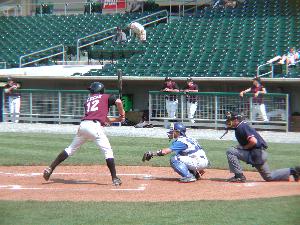What Scouts Look For
When Evaluating Catchers
by Ed Herrmann
Scout-Coach-Tutor
Ed Herrmann.Com
Evaluating Catchers

The evaluation of high school catchers may be the most subjective of all the scouting involving young players. Many professional scouting directors will tell you that after pitchers the drafting of high school catchers has the biggest "wash out" rate percentage among players drafted each year.
Some scouts like catchers with long lanky bodies, others prefer shorter more compact or thick bodies. Beauty is truly in the eye of the beholder when it comes to evaluating catchers.
It used to be that if a catcher was a great defense player (what is known as a catch and throw guy) he had a chance to make it to the Major Leagues. In today's game the catcher is also expected to provide a substantial offensive output.
The days of a professional baseball catcher being a big slow-footed wide body are long gone.
It is important to remember that the overall evaluation of a player's baseball skills is subjective to the scout's personal opinions about how those skills will play at the Major League level.
Catcher
A scout will time a catcher's throw to second base by starting his stopwatch as the ball hits the catcher's glove and he stops it when the ball is caught at second base. (this is called the "pop to pop" time) A good scout will anticipate the ball-to-glove contact in order to start and stop the watch.
- A solid Major League time is under 2.00 seconds
- Most Major League catchers are in the 1.80 - 1.98 range, on average
- In college, times under 2.10 will often work
Throwing times will be affected by the glove-to-hand transfer, or how quickly the ball can get into the throwing hand. The catcher's footwork and throwing action will also affect the release time for a catcher. These things can be improved, and a scout will judge how easily those changes may come for the catcher - based on the overall athleticism of the catcher - as part of the evaluation.
Other Things Scouts Look For
- Stance - Athleticism
- Setting Up For Pitches
- Framing of Pitches
- Blocking Skills
- Throwing Footwork
- Fielding of Bunts
- Plays at the Plate
- On Field Leadership
- How a catcher works during a bullpen - This can be very important -
Does the player practice like a game - or does he receive the pitches in
the bullpen with less than full effort and skills
There is little emphasis as to how a catcher "calls a game" or works
his pitchers in high school. This is due to most of these items being
done by the coaches. These are skills that can be learned. Professional
scouts understand this and do not consider these factors significantly
when evaluating a catching prospect.
Ed Herrmann.Com
|